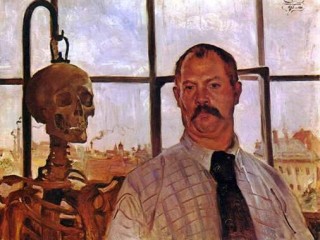
Lovis Corinth biography
Date of birth : 1858-07-21
Date of death : 1925-07-17
Birthplace : Tapiau (Gvardeysk), Province of Prussia, Kingdom of Prussia
Nationality : German
Category : Arts and Entertainment
Last modified : 2011-10-17
Credited as : artist painter, printmaker, Ecce Homo
Lovis Corinth was a leading German artist of the late 19th-early 20th century with a prodigeous output of work.
Lovis Corinth was born in 1858 in the town of Tapiau in East Prussia (now the Soviet Union), the son of a tanner. He was named Louis, but came to be called Lovis because he later signed his name with a Latin-style "u" which is written as a "v". Corinth grew up in a rural setting, with little or no exposure to works of art. From a very early age, however, he enjoyed sketching and painting. At the age of nine he was enrolled first in the public school in nearby Konigsberg and then at the Konigsberg Academy of Art.
Corinth continued his artistic training in Munich (1880-1882), and then in Antwerp and Paris (1884-1886), where he studied with the well-known academic painter Adolphe William Bouguereau. During this period Corinth remained uninfluenced by the "modern" painters of the day, such as Manet and Monet; he preferred instead the naturalistic style of Wilhelm Leibl, who had been a pupil of Gustave Courbet. He also admired works by Rubens in the Louvre in Paris and by Rembrandt.
Corinth returned to Germany in 1891 and continued his painting career. He became a part of the art world of Berlin at the turn of the century and in 1901 he opened a school for painters there. His first student, Charlotte Berend, became his wife two years later.
In the first decade of the 20th century, Corinth's palette became brighter and he began to employ the freer brush-work characteristic of the German Impressionists, represented by Max Liebermann. In addition to his landscapes and figure compositions, he achieved great success as a portrait painter, and his services were much in demand. Corinth was elected chairman of the Secession, the Berlin artists' association to which he had belonged since 1899, in 1911. In that same year he completed 61 oils, as well as many drawings, etchings, and lithographs, and all of his work was selling well.
At the end of the year, however, Corinth suffered a massive stroke which threatened to end his career. His left side was paralyzed, but through great perserverance and determination he was able to resume painting the following year. From 1912 until his death in 1925 Corinth continued to work and to struggle against his increasing debility. He produced some 500 oils and about 1,000 prints, in addition to drawings and watercolors. He was named president of the Berlin Secession in 1915.
In Corinth's late work expressive elements dominate, reflecting his own personal struggles against his illness and, perhaps, an increased perception of the world around him. He created numerous portraits and self-portraits, notable for their profound psychological insights, and his work influenced later generations of German artists.
Corinth died in July 1925 while on a visit to Holland to see paintings by Rembrandt and Frans Hals. One of his most famous paintings, Ecce Homo, was done earlier in the year. His late work was condemned by the Nazis as degenerate. Today, however, Corinth is seen as a major artist whose paintings combined elements from the Old Masters he admired, such as Rembrandt, with late 19th-century Impressionism to create, in his late work, a fully modern idiom. His paintings, drawings, and prints are included in numerous public and private collections throughout the world.
The majority of writings on Lovis Corinth and his art are in German. His widow, Charlotte Berend-Corinth, published a catalogue of all of his works in 1958. Corinth was included in a major exhibition titled German Art in the 20th Century, Painting and Sculpture 1905-1985, held at the Royal Academy of Arts, London, in 1985. The accompanying catalogue contains numerous reproductions of his works, as well as biographical information.



















